

The Insurance Council of Australia (ICA) has urged the Albanese Government to allocate a sustained annual fund of $250 million, focusing on acquiring and elevating residences located in high flood-risk areas.
In its recent pre-Federal Budget submission, the ICA suggested that this financial commitment should be matched by states and territories, resulting in a combined yearly fund of $500 million. The joint effort aims to relocate approximately 750 families annually from flood-prone zones.
The initiative is an extension of existing programs established in New South Wales and Queensland following the unprecedented floods of 2022. Joint funding of about $1.6 billion has been earmarked for property buybacks, with approximately 1,300 buybacks offered so far.
The ICA emphasised the need for ongoing funding to empower flood-exposed communities to make localised decisions addressing their challenges.
The proposed fund is intended to align with the existing $200 million per year Commonwealth Disaster Ready Fund, contingent on matched state funding, focusing on enhancing community resilience through various projects.
The ICA also proposed an annual allocation of $5 million to enhance risk management in sectors facing heightened frequency of personal injury claims.
The submission encompasses additional measures aimed at mitigating cost-of-living pressures by reducing risks and subsequently alleviating pressure on insurance premium prices. These measures include:
ICA CEO Andrew Hall emphasised the imperative need for increased investment in response to the substantial flooding events experienced from 2022 to the present summer.
“The major flooding events over this summer and back to 2022 have demonstrated the scale of the challenge Australia faces in responding to extreme weather events, and why more investment is urgently needed to better protect Australian lives and properties,” he said. “The cost of insurance has seen a significant increase over the past 12 months, driven by the impact of flood events, building and repair cost inflation, and the cost of reinsurance.
“While there is no one solution that would immediately work to counter these factors, collectively, the measures outlined in our pre-Budget submission work to relieve upward pressure on premiums by reducing risk, which is the ultimate driver of insurance costs, and so support the community’s need for action on cost-of-living.”
In other news, the ICA recently published its initial estimated losses for Tropical Cyclone Jasper.
